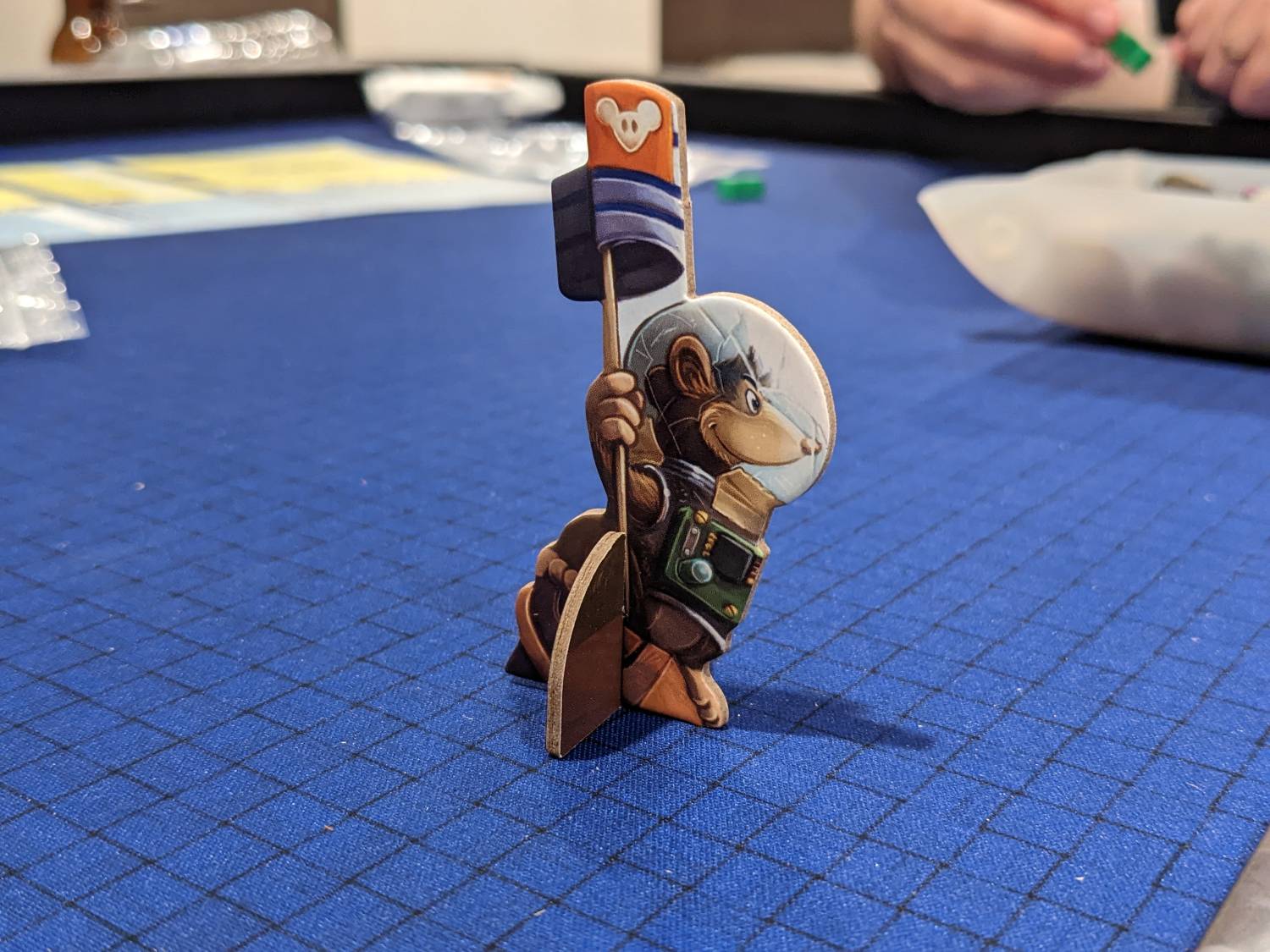My two kids, ages 8 and 5, love games. I usually steer them towards family games, particularly games that align with my 5-year-old son so that all of us can play together. Bonus points if the game is cooperative, because my son still can’t deal with losing.
My hope is that one day, my kids can scale up to, say, Brass: Lancashire or a light Lacerda, like Vinhos: Deluxe Edition. For now, games like The Quest Kids and Turtle Mania do the job for family play, but I am just setting the table for the days when I can try to go toe-to-toe with my kids in a medium weight Euro puzzle.
But let’s imagine my kids were, say, 12 and 9. First Rat (2022, Pegasus Spiele) might be the perfect game for what I’m trying to build towards, a game that rewards efficiency, timing, and has the production elements I look for in a Eurogame experience. Plus, you’ve got some of the hallmarks of standard Euro fare: scoring tracks, variable player powers, resource gathering, milestones, and the like.
Combine all of that with rats and a game board that reminds older players of a darkly-shaded version of Candy Land, and you’ve got something that will really shine with parents who want their kids to eventually play lightly-interactive games that play in about an hour. The biggest surprise for me: First Rat plays relatively well with adult audiences, too.

Gather Stuff, Go to Space
In First Rat, you are playing as a bunch of rats.
I know that this may be a shock to those who bought a game called First Rat, but it’s true. You’ll have to move your rats from the start space at the bottom of the board to become “Rattronauts” by getting them into a rocket that will take off when a single player either places eight of their ten scoring markers, or get all four of their rats onto the ship.
Beginning the game with two of their four-rat allotment, players take turns moving rats (workers) 1-5 spaces towards the rocket or moving multiple rats 1-3 spaces so long as those rats all land on spaces of the same color. This minor but thinky moment makes movement interesting every turn as you try to take advantage of empty spaces while still gathering the stuff you need to build the rocket.
After a player moves, they grab stuff based on the spaces they land on. Gathering resources allows for a player to pay those goods to build parts of the rocket ship. If you can’t get the resources you need, some spaces just give you cheese, both to feed other players on your turn if you ever land on a space occupied by opponents, or to spend 10 cheese to drop a scoring marker on the map.

Other spaces reward you with apple cores, which are used to move around a mini rondel that grants things like ongoing player powers, more worker rats, or end-game points on one of the tracks. There’s even a Light Bulb track that increases the yield you’ll get when you grab stuff from the map, which also gives you chances to score points as you work your way up the income track.
Each turn, players have access to two optional actions. If you’ve landed on one of the three shopping spaces, you can buy stuff: end-game point multipliers, one-time boosts to a resource space, or ongoing yield bonuses when you grab certain resources from the board. To end turns, if you have all of the resources needed to build rocket parts or turn in cheese, you can do that too.
A note about those stores: I love that players have an option to pay for goods when shopping, or steal them (like a dirty rat) and return to the start space instead. I always find that it’s worth it to steal at least once, mainly because some of the actions in the shopping spaces are really good and you are not necessarily in a rush to get all four of your rats onto the rocket.
The scoring tracks are a race; in each category it pays to do things first, because scores can range from 8-10 points if you are the first to do something in a game, before dropping to half of that or less if you get there last. Any number of players can score each track, but the juiciest bonuses go to those who win the race.

Everything You’ve Told Me Sounds Like We Have a Euro
First Rat could offer the gaming experience of your dreams by setting the barriers for entry quite low. (OK, you forced my hand: yes, First Rat would make for an excellent “gateway” game into these kinds of experiences.)
My son wouldn’t be able to pick up the nuances of why you don’t want to rush all of your rats directly to the ship; my daughter may focus on just one of the scoring tracks to ensure she crushes that instead.
But if my kids were slightly older, I would be in love. There’s a rondel, which will help when I want to teach The Red Cathedral or Glen More II: Chronicles down the line. It’s got all kinds of milestones and even a little income track, so I can get Khora: Rise of an Empire all queued up for future plays. Worker placement? Oh my goodness, half the games in my collection suddenly make a little sense to the kids, even if they don’t understand the strategies just yet.
So, the basics are here. First Rat doesn’t do anything wild, but it does have style; I’d much rather gather calculators, tin cans and baking soda than Eurogame #10,487 which asks me to gather wheat or wood. And First Rat does veer into point salad territory, as almost everything will eventually score me some points here. (I’m OK with this, since I need the kids to feel like they are making progress.)

Smells Like a Rat (In a Good Way)
First Rat is a pleasant ride. It becomes even more pleasant if you plan to play it with the right audience. I think this would be a perfect family game with 3-4 players who want to race for the win without much in the way of conflict. The game oozes cute: the artwork is cute, the “Super Rat” player powers can be fun to add to a player’s rat meeple, the theme keeps things light and doesn’t get in the way of little things like making sense.
With that last comment, I have to acknowledge some of the game’s shortcomings. You don’t even have to build any parts of the rocket for the game to end. First Rat never really explains why you can use the tunnels on the game board (“ladders”, in my mind, since it feels like they are ripped right out of a game of Chutes and Ladders) by providing, say, a single tin can; why does it cost resources at all? You could just force a turn to end if a rat is able to shoot up the board faster.
The game does have a decent solo mode that is easy to manage and does an OK job of simulating a two-player game by giving the AI all four of its rats to begin play, blocking some of the board because landing on occupied spaces costs you cheese. The solo is a great way to learn the game, and if you are looking for a decent challenge, I would start with the harder difficulties right away (there are four levels in the solo game).
First Rat never blew me away but I enjoyed the puzzle, particularly figuring out ways to move rats in unison so that I could maximize the resource collection. I may hold onto it for a while so that I can give my kids the gateway Euro experience that they deserve.
One of First Rat’s co-designers is Virginio Gigli, who has never steered me wrong with his heavier fare (co-designer of games like Grand Austria Hotel: Let’s Waltz!, Alma Mater, Lorenzo il Magnifico, and Golem); it’s not a surprise that First Rat works so well.












Coming from the same angle of playing with younger children I have increasingly come to the conclusion that many aspects of Euros are poor game design. Like victory points for example. The point of a game is to tell a story with a resolution -;imagine it you watched a film and at the end everyone counted up victory points and that was the end of the story!